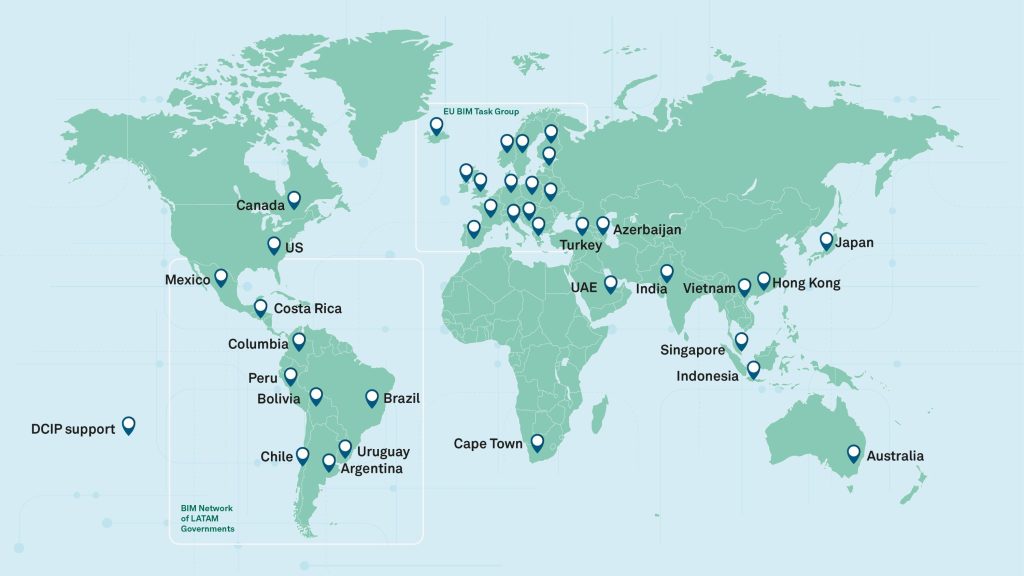Digital Construction International Programme (DCIP)

The Digital Construction International Programme (DCIP) advances global infrastructure through the adoption of digital construction techniques such as Building Information Modelling (BIM) aligned with international standards.
The programme helps governments and infrastructure owners respond effectively to local and global challenges including rebuilding critical infrastructure, addressing climate resilience, supporting the drive towards net zero and closing the infrastructure gap. BIM helps secure better value for public money enabling infrastructure investment to go further.
DCIP also connects the UK export ecosystem to overseas market opportunities and supports international collaboration, innovation, and trade growth.
Objectives
Grow international public sector demand for digital construction methodologies
Increase public sector capacity for introducing, procuring, and using digital construction, aligned with international standards
Connecting UK agencies, bodies, and exporters of digital construction-related solutions to opportunities overseas

45+ partner countries
across four geographic regions
2200+ public officials trained
27 SMEs, 11 UK consultancies, 5 industry bodies
engaged in DCEG events in 2025
Benefits
Economic outcomes
Digital construction methodologies, such as BIM, have resulted in[1]:
- A reduction in unbudgeted change by up to 40%.
- Contract value savings of up to 10% through improved construction coordination;
- A 7% reduction in overall project delivery time.
In addition, a UK study found that information management for infrastructure owners can secure between £6.90 and £7.40 in direct cost savings for every £1 invested[2]: a seven-fold return on investment.
Environmental outcomes
Digital construction is a key enabler to reaching net-zero targets, e.g., for methods to calculate embodied carbon, the energy efficiency of assets and whole-life carbon footprints.
Social outcomes
An important social outcome of digital construction is its power to build digital skills and knowledge, creating jobs and reskilling workers to participate in the digital economy.
Building Information Modelling (BIM)
At the heart of digital construction is the adoption of Building Information Modelling (BIM) aligned with international standards. BIM is information management for the construction and operation of the built environment.
It is a technique to enable better decision-making for the delivery and operation of the world’s infrastructure. As a coordinated set of processes, supported by technology and standardization, BIM adds value through the creation, management, use and sharing of digital information about an asset throughout its whole lifecycle.
“The Catapult has helped us to connect Cape Town’s BIM programme to our infrastructure development plans, supporting our goal to become a more resilient city, and a leader in digital transformation in South Africa and across the African continent.”Rob Laubscher, Head of Engineering Innovation Unit, City of Cape Town
What we offer
Policy and strategy guidance for local outcomes realisation
Advisory and guidance for BIM implementation and compliance
Knowledge transfer and provision of knowledge products
Capability and capacity development of the public and private sector
Digital Construction Exports Group (DCEG)
The Digital Construction Exports Group (DCEG) works with UK enterprises and SMEs interested in exporting to international markets. For more information about how DCIP connects exporters of digital construction-related solutions to opportunities overseas, visit our Digital Construction Exports Group.
Resources
Global BIM Network’s knowledge base
Explore and contribute to the Global BIM Network’s knowledge base, hosting over 560 resources from over 70 countries
Submit your resource to the knowledge base, here.
Construction Digital Transformation Playbook
Access the Public sector Construction Digital Transformation Playbook for information, ideas and inspiration on each step of your digital transformation journey Playbook – Global BIM Network
Contact
For more information about working with the DCIP on your country’s digital transformation journey, please contact: dcip@cp.catapult.org.uk

[1] “Report: “Building Information Modeling (BIM): Benefits, Risks and Challenges”, Stanford CIFE
[2] “Report: The Value of Information Management in the construction and infrastructure sector”, KPMG; Atkins


